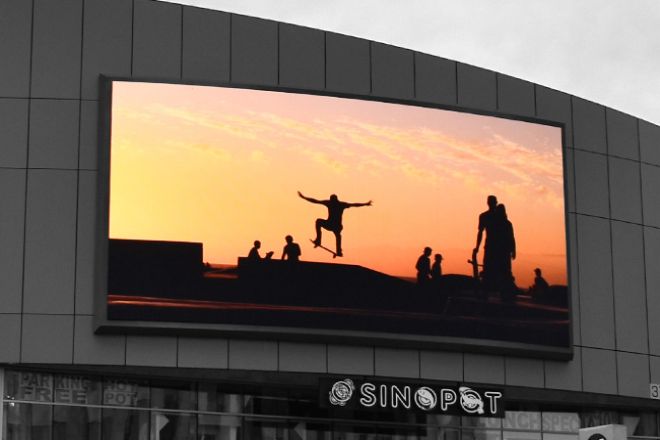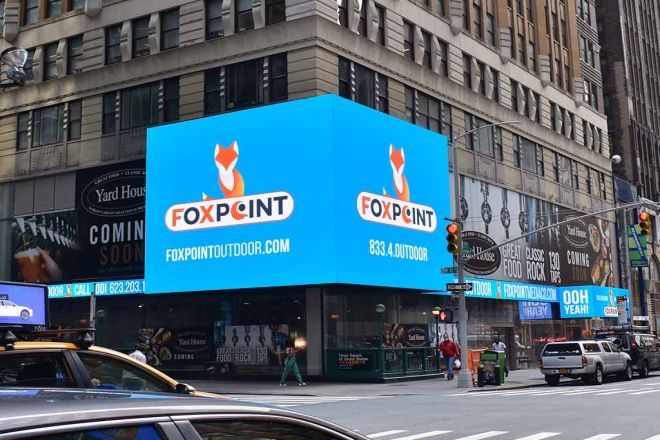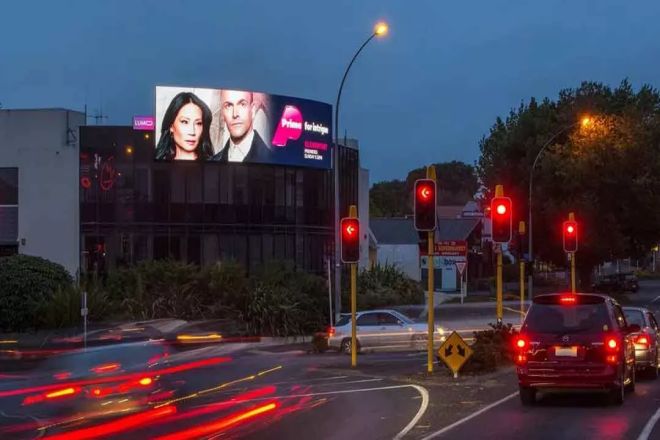Introduction

When night falls, every corner of the city is lit up by gorgeous outdoor LED display screens. They are not only messengers of information but also a perfect fusion of technology and art. However, have you ever wondered what determines the long-lasting shine of these brilliant screens without being eroded by wind and rain or tested by time?
The answer lies in 7 key factors. From the fine selection of materials to the ingenuity of craftsmanship, from environmental adaptation to careful maintenance, every detail is related to the life of outdoor LED display screens.
This article will take you to explore these decisive factors in depth, uncover the secrets of their long-lasting shine, and let you feel the power of technology and the importance of maintenance in understanding. Follow our steps and walk into the mystery of the life of outdoor LED display screens together!
1. How long is the life of an outdoor LED display screen in general?
As an important carrier of modern urban landscape and information dissemination, the service life of outdoor LED display screens has always been the focus of attention inside and outside the industry.
The service life of such display screens is usually evaluated by cumulative working time; that is, the “life span” is measured in hours. Under ideal conditions, high-quality outdoor LED displays are designed to be durable enough, and their theoretical lifespan can easily reach and exceed 100,000 hours.
This number is converted into actual years of use, which means that under normal operation and maintenance, an outdoor LED display can theoretically continue to serve for 10 to 15 years, bringing a lasting visual feast and information transmission function to the city.
However, the actual service life will fluctuate due to various factors. Therefore, when selecting and using outdoor LED displays, it is necessary to comprehensively consider the above factors and take corresponding measures to extend its service life to ensure that it plays a greater role in urban landscape construction and information dissemination.
2. What factors determine the life of outdoor LED displays

The life of outdoor LED displays is affected by a variety of factors. The following is a detailed analysis of these determining factors:
1). Component quality
- LED lamp beads:
As the core light-emitting element of the display, the quality of LED lamp beads directly determines the display effect and life of the display.
High-quality LED lamp beads have excellent attenuation characteristics, water vapor penetration resistance, and UV resistance and can maintain stable luminous performance and long service life in harsh outdoor environments.
- Other supporting parts:
In addition to LED lamp beads, the display screen also uses a variety of supporting parts such as circuit boards, plastic shells, switching power supplies, connectors, and casings. The quality of these parts is equally important. Any quality problem in any part may reduce the life of the display screen.
2). Production process
Exquisite production technology can ensure that the display screen’s performance indicators are in the best state and improve its reliability and durability.
The production process includes storage and pretreatment of components, furnace welding, three-proof treatment, waterproof sealing, and other links.
Effective production technology can reduce failures caused by defects in the production process, thereby extending the life of the display screen.
3). Usage and environment
- Usage:
Long-term high-brightness operation, frequent switching on and off, and other bad usage habits will accelerate the aging process of the display screen and shorten its service life.
Therefore, it is crucial to use the display screen reasonably and avoid long-term high-load work to extend its life.
- Usage environment:
Outdoor LED display screens need to face various harsh natural environments, such as high temperatures, high humidity, strong ultraviolet rays, wind and sand, etc. These environmental factors will accelerate the aging of the display screen and reduce its service life.
Therefore, when choosing a display screen, it is necessary to consider its protection level and adaptability and take corresponding protective measures during use.
4). Maintenance
Regular maintenance is essential to extend the life of the display. This includes cleaning the screen surface, checking circuit connections, and replacing damaged LED lamp beads in time.
Through maintenance, potential problems can be discovered and dealt with in time, preventing small problems from turning into major failures and thereby extending the life of the display.
5). Power supply and cooling system
- Power supply system:
A stable and reliable power supply system can provide a continuous power supply for the display to avoid failures caused by voltage fluctuations or sudden power outages.
Therefore, choosing a high-quality power supply system is of great significance to extending the life of the display.
- Cooling system:
Outdoor LED displays generate a lot of heat during operation. If the heat dissipation is poor, the temperature will rise and accelerate the aging process of the display. Therefore, a good cooling system can ensure that the display operates at normal operating temperature and extend its service life.
6). Operation and software upgrade
- Operation and use:
Follow the operating procedures to avoid damage to the display caused by improper operation. For example, avoid scratches or collisions on the display, and avoid using incompatible playback software.
- Software upgrade:
Keep the control system software updated and upgraded for better performance and compatibility. Software upgrades can fix known problems and vulnerabilities, improve the stability and security of the system, and thus extend the life of the display.
7). Manufacturing standards
Manufacturing standards are one of the key factors that determine the quality and life of outdoor LED displays.
Due to differences in each supplier’s technical strength, production process, material selection, etc., their manufacturing standards will also be different, which directly leads to differences in the performance, reliability, life, etc., of the manufactured LED displays.
3. What are the benefits of long-life outdoor LED displays?
Outdoor LED displays with long life have many benefits, which are not only reflected in economic benefits but also involve user experience, environmental friendliness, and brand image. Here are some of the main benefits:
1). Economic benefits
- Reduce replacement costs:
Displays with long life mean longer service life and reduce the costs incurred by frequent equipment replacement. This includes the purchase cost of new equipment, installation costs, and possible downtime losses.
- Reduce maintenance costs:
Long-term stable displays reduce the costs incurred by fault repairs. In addition, high-quality displays usually have a lower failure rate, reducing the frequency and cost of repair work.
By reducing replacement and maintenance costs, long-life displays can recover investment costs faster and improve return on investment.
2). User experience
- Stable display effect:
Displays with long life usually have more stable display effects, reducing problems such as brightness reduction and color distortion caused by equipment aging. This provides users with a better visual experience.
- Reduced interference:
Frequent replacement and maintenance work may interfere with users and affect their normal use. Long-life displays reduce this interference and improve user satisfaction.
3). Environmental friendliness
- Reduced electronic waste:
Electronic waste is one of the important sources of environmental pollution. Long-life displays reduce the amount of electronic waste generated by equipment obsolescence, which helps protect the environment.
- Energy saving and emission reduction:
High-quality displays usually have a higher energy efficiency ratio, which can reduce energy consumption while ensuring the display effect. This helps to reduce energy consumption and carbon emissions and achieve the goal of energy saving and emission reduction.
4. How to improve the service life of outdoor LED displays?

Improving the service life of outdoor LED displays requires multiple aspects. Here are some key measures:
1). Select high-quality raw materials
- LED lamp beads:
Select high-quality LED lamp beads to ensure that they have low attenuation characteristics, good water vapor penetration characteristics, and UV resistance. These characteristics help to extend the service life of the lamp beads, thereby improving the durability of the entire display.
- Other key components:
Components such as driver chips and power supplies should also select high-quality products to ensure the stability and durability of the display.
2). Exquisite production technology
- Production process control:
Exquisite production technology can ensure that the performance indicators of the display screen are in the best state and improve its reliability and stability.
Suppliers should strictly control the production process, including storage and pretreatment of components, furnace welding, three-proof treatment, waterproof sealing, and other links.
- Quality control:
Establish a strict quality control system to conduct comprehensive inspections of raw materials, semi-finished products, and finished products.
Through strict quality control, potential problems can be discovered and dealt with in a timely manner to ensure that the product meets the design requirements.
3). Reasonable use and maintenance
- Avoid long-term high-brightness display:
Long-term high-brightness display will accelerate the aging of LED lamp beads and reduce service life. Therefore, during use, the brightness should be set reasonably according to actual needs to avoid long-term high-brightness display.
- Regular cleaning and maintenance:
Outdoor LED display screens are prone to accumulate dust and dirt, affecting the display effect and heat dissipation performance. Therefore, the surface of the display screen should be gently wiped with a soft cloth or special cleaner regularly to remove dust and dirt.
At the same time, regularly check the connection wires, power supply, and other components of the display screen to ensure their normal operation.
- Environmental adaptability:
Try to install the display screen in a well-ventilated environment that avoids direct sunlight high temperature and humidity. This can reduce the impact of environmental factors on the display and extend its service life.
4). Stable power supply
- Stable power supply:
Ensure that the power supply is stable and the grounding protection is good. Avoid using the display screen under harsh natural conditions, especially in strong thunderstorm weather, to prevent power shock and equipment damage.
5). Waterproof and moisture-proof design
- Waterproof sealing:
The display screen should have good waterproof sealing performance to prevent moisture and moisture from entering the screen body and causing damage.
- Internal protection:
Water, iron powder, and other easily conductive metal objects are strictly prohibited from entering the screen body to avoid equipment short circuits and fire.
6). Reasonable playback content and speed
- Avoid high-contrast images:
High-contrast images will cause the LED display’s lamp beads to switch frequently and accelerate aging. Therefore, the playback content should be set reasonably to avoid displaying high-contrast images for a long time.
- Control the playback speed:
Avoid too fast playback speed and leave enough response time for the LED display screen to reduce the impact and damage to the display screen.
7). Software update and upgrade
- Keep the software updated:
Regularly update the software of the LED display control system to obtain better performance and compatibility, which will help extend the service life of the display screen.
Conclusion
In summary, the life of outdoor LED display screens is affected by many factors, from controlling the quality of raw materials at the source to refined production processes to scientific use environment and thoughtful maintenance; each link is crucial.
At the same time, with the advancement of technology and the development of the industry, the continuous optimization of power supply and cooling systems, the standardization of operation and use, and the continuous upgrading of software systems have also provided strong support for extending the life of the display screen.
Finally, if you want to know more about LED display screens, please get in touch with us.
